Learn how to make sourdough starter with just two ingredients-gluten free flour and water! This recipe includes tips for an easy to follow gluten free sourdough starter recipe and process. You will be an expert in no time if you follow this process!
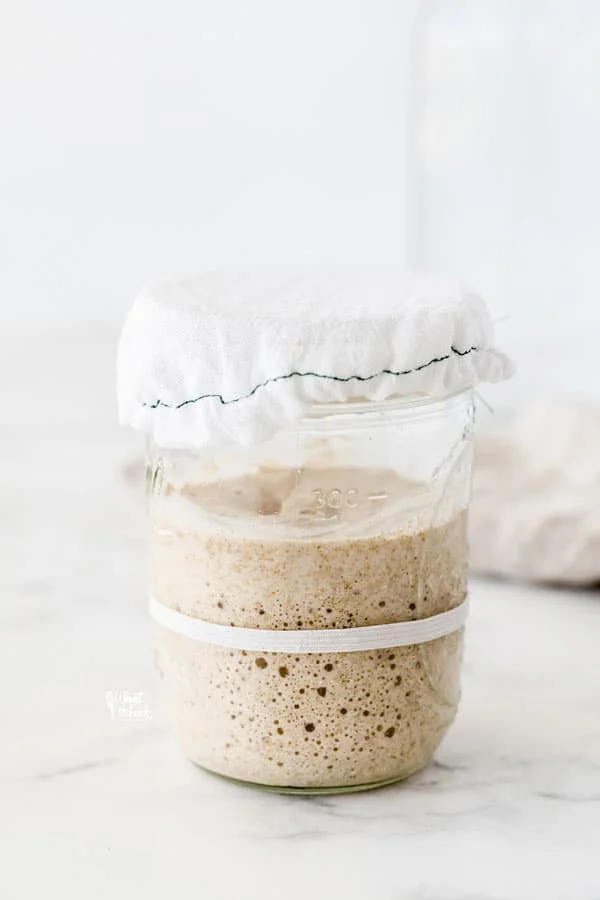
This post contains affiliate links for products and ingredients I use and love. You can read my full disclosure here. Thank you for supporting What The Fork Food Blog so I can continue to provide you with free gluten free recipes ♥
How to Make Sourdough Starter Gluten Free with just 2 ingredients
I’ve always been intrigued by sourdough but never had the courage to start my own. Since there’s been a yeast shortage, I figured now’s as good a time as ever to dive right in.
And boy, did I dive in with this gluten free sourdough starter recipe.
The world of sourdough is a vast one. There’s so much to learn and once you start, it’s like falling into a rabbit hole. Hence, the reason why I named my very first starter Alice.
That’s right, I said first because once I started with one, I had to start others. Different flours yield different flavors and they all behave a little bit differently. See why I said it’s like falling into a rabbit hole?
You can spend hours and hours researching and reading but the best thing to do is just start making sourdough starter.
Did you make this recipe? Leave a star rating and let me know in the comments! You can also leave a photo/comment on this pin for others to see.
You’ll soon realize, once you start researching gluten-free sourdough bread recipes, that there are so, so many variations made with multiple different flours, starches, and binders. Using this sourdough starter recipe, you could also tickle your sweet tooth by making this easy gluten free sourdough chocolate cake.
Gums like xanthan gum or guar gum, psyllium husk powder, whole psyllium husk, etc. My head was literally spinning trying to figure it all out.
I needed to make this as easy as possible not only for you but for my own sanity.
So today, I’m sharing my recipe for a gluten-free sourdough starter made with one kind of gluten-free flour. You can choose which flour blend works best for you and I’ll go over the different flours you can use below and what flours I use in my own starters (I have multiple).
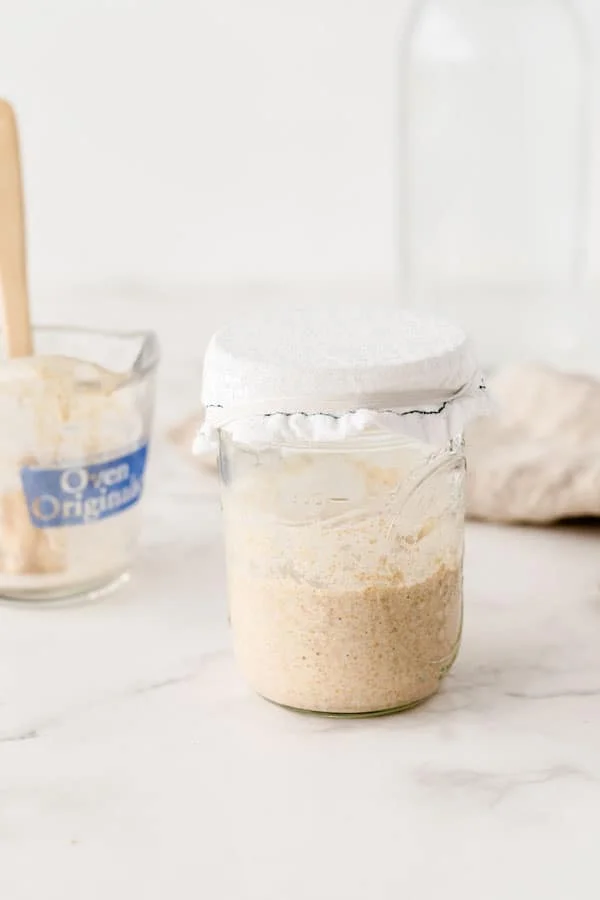
What is Sourdough Starter?
A sourdough starter is what you use to make sourdough bread. It’s a mixture of water and flour that ferments and is fed regularly to cultivate wild yeast and bacteria. It’s used to leaven bread and is the natural leavening alternative to commercial yeast.
Is Sourdough Gluten Free?
As long as the starter (and bread) is made with gluten free flours, then the sourdough bread is gluten free.
I go over the gluten flours to try and GF flours to avoid towards the end of this post.
Key Ingredients for a Simple Gluten-Free Sourdough Starter
- Gluten-Free Flour – I currently have 4 starters and all of them are made with different flour.
- My first one is made with Bob’s Red Mill 1:1 Gluten Free Baking Flour and it’s a great starter for me. It’s thicker than my other starters and has a consistency similar to Ricotta Cheese.
- I also have starters made with Sorghum Flour, Brown Rice Flour, and my Nightshade Free Gluten-Free Flour Blend. The starter pictured in this post is made with brown rice flour.
- Your starter’s consistency and smell will depend on the flour it’s made with and your environment. Each starter will be unique.
- Keep reading below for more gluten-free flours to try.
- Water – filtered water is best
- Tap water that contains chlorine will not work with the starter – the chemicals will kill the wild yeast and good bacteria. If you only have access to tap water, you can boil it and then cool it to room temperature before using it.
Equipment Needed to Make Sourdough Starter
- Glass Jars – I use mason jars and these Weck Jars. They’re the perfect size, there’s plenty of room for the starter to breath, remove the rubber gasket to cover without it being airtight, and the opening is wide enough for adding ingredients and stirring right in the jar.
- Digital Kitchen Scale – you’ll measure both the flour and water by weight when making your starter and feeding it. Using a digital kitchen scale is the most accurate way to do this.
- Silicone Spatula – I use a Mini Supoon to stir my starter together. I use the same spatula to scrape down the sides of the jar when I’m feeding my starter. It scrapes the sides so clean, it’s amazing. I find that being able to scrape down the sides of your jar helps eliminate any risk of mold.
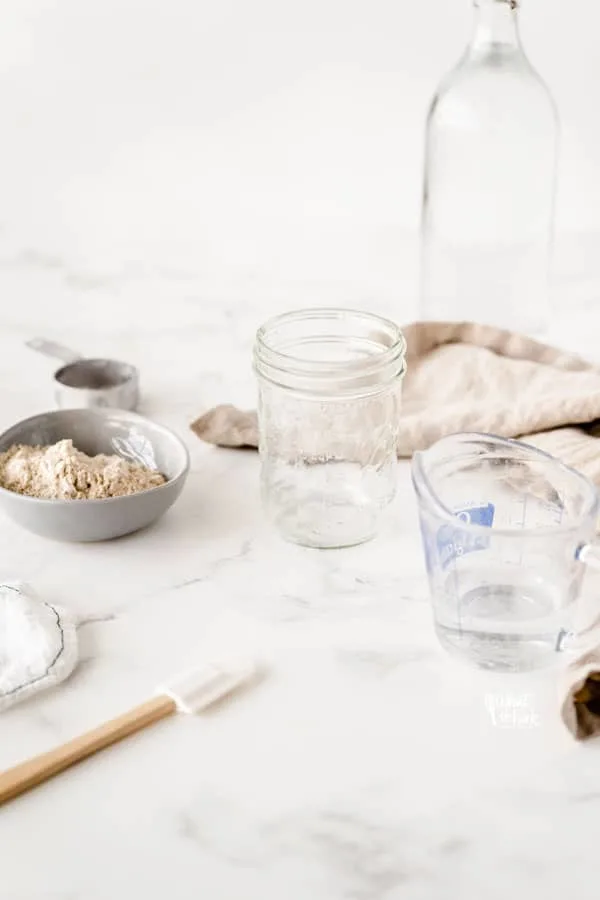
How to Make Sourdough Starter
Step 1. Add 25 grams gluten-free flour and 25 grams of filtered water to a glass jar. Mix well to combine.
Step 2. Follow the daily feeding schedule below. You can also download my free printable sourdough schedule here.
Schedule for Feeding Sourdough Starter
Day 1 – Add 25 grams flour and 25 grams water to your glass jar. Mix well and scrape down the sides the best you can.
Day 2 – No discard. Add 25 grams flour and 25 grams water
Day 3 – 6 Stir the starter and discard all but 25 grams of the starter. Add 25 grams flour and 25 grams water. Mix well and scrape down the sides the best you can.
Day 7 – 10 Stir the starter and discard all but 25 grams of the starter. Add 50 grams flour and 50 grams water. Mix well and scrape down the sides the best you can.
Day 11 – 14 Stir the starter and discard all but 25 grams. Add 75 grams flour and 75 grams water. Mix well and scrape down the sides the best you can.
After day 14, you can continue to maintain this feeding schedule if you plan on baking with it soon or you can now store and maintain your starter in the refrigerator.
I covered the whole process in a Facebook Live video series in my Gluten Free Baking Club group. All videos and posts are listed in the group files as Sourdough Starter. I highly suggest watching the videos and reading the posts because I answer lots of questions and it’s a great visual tool to learn from.
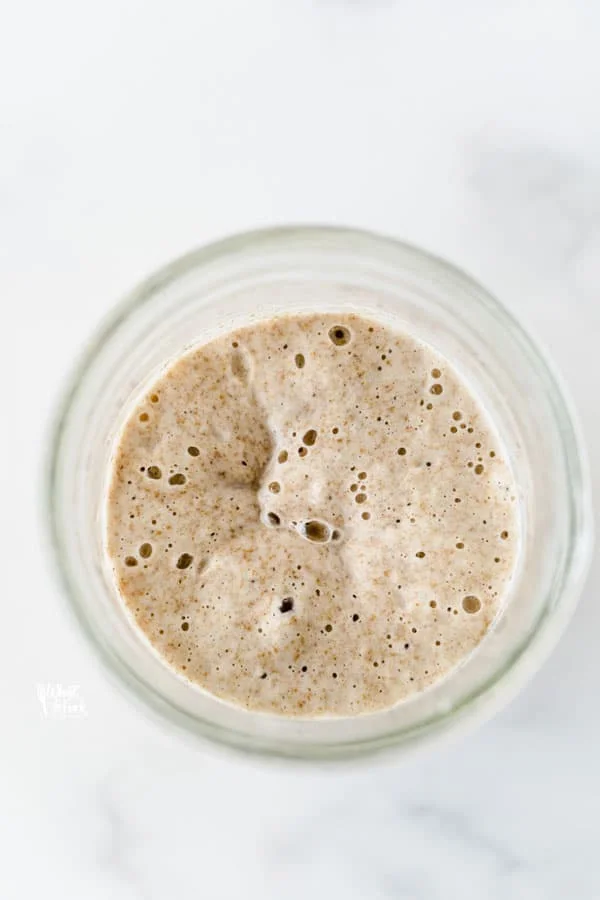
Pro Tips for Making a Gluten-Free Sourdough Starter
- Don’t use a metal spoon to stir your starter. I use a Mini Supoon (mentioned above in the equipment section) but you could also use a wooden skewer or small wooden spoon.
- Don’t seal your container airtight. You want air to be able to flow into your jar and you want the gases created by your bubbling starter to be able to escape. With my Weck jar, I don’t use the rubber sealing ring, I just place the glass lid on top and there’s enough gap for the lid to move slightly.
- You can also cover the jar with a coffee filter or paper towel and use a rubber band to hold it in place.
- Scrape down the sides of your jar the best you can. The cleaner the sides of the jar, the better. Doing this will reduce the chance that mold or mildew will start to grow.
- You can change flours without having to start over from day 1. If you have to switch flours, just discard as you would at a normal feeding and keep 25 grams of your starter. Then feed it with water and the new flour you’re switching to.
- Add more flour or water as needed. I like to stick to a 100% hydration starter, meaning it’s made with equal parts flour and water. However, some flours require more or less water for good consistency. If you have to add more water or more flour, always measure it by weight to see how much extra you need to add and take note of it. That way, you’ll know what % hydration your starter is and that will come in handy when you start baking with it.
- The older the starter, the betteryour bakes will be. Ideally, your starter should be at least 14 days old before baking a loaf of sourdough bread with it, and even longer, the better.
- An older starter will have better flavor and have a stronger rise. I noticed a change in the quality of my loaves of bread (for the better) when my starter was over a month old.
- Don’t let this information intimidate you. It’s a lot to take in, it’s a lot to read, and it’s a lot to process. I get it. But don’t let it stop you from trying. The best thing to do is just start and then figure it out as you go along.
- Pick your flour, start the feeding schedule, and then learn and read as you go.
- Slow and steady steps are all it takes. You have two weeks of developing your wild yeast cultures before trying your hand at baking bread anyways.
- Watch my Facebook Live video series in the Gluten Free Baking Club group. All videos and make-along posts are listed in the group files as Sourdough Starter. I highly suggest watching the videos and reading the posts because I answer lots of questions and it’s a great visual tool to learn from.
- You can follow the series and comment with photos of your own starter for guidance in the group. It’s designed to let anyone join the process at any time!
Other Flours To Try in your Gluten-Free Sourdough Starter
- Sorghum Flour – I have a sorghum flour starter, Sulley, and it’s a great whole-grain option.
- Brown Rice Flour – one of the most popular flours for gluten-free sourdough starters.
- Buckwheat Flour
- Teff Flour
- Quinoa Flour
- Oat Flour – Use certified gluten free oats or Purity Protocol Oats if you have Celiac Disease and you can learn how to make your own oat flour here.
- Millet Flour
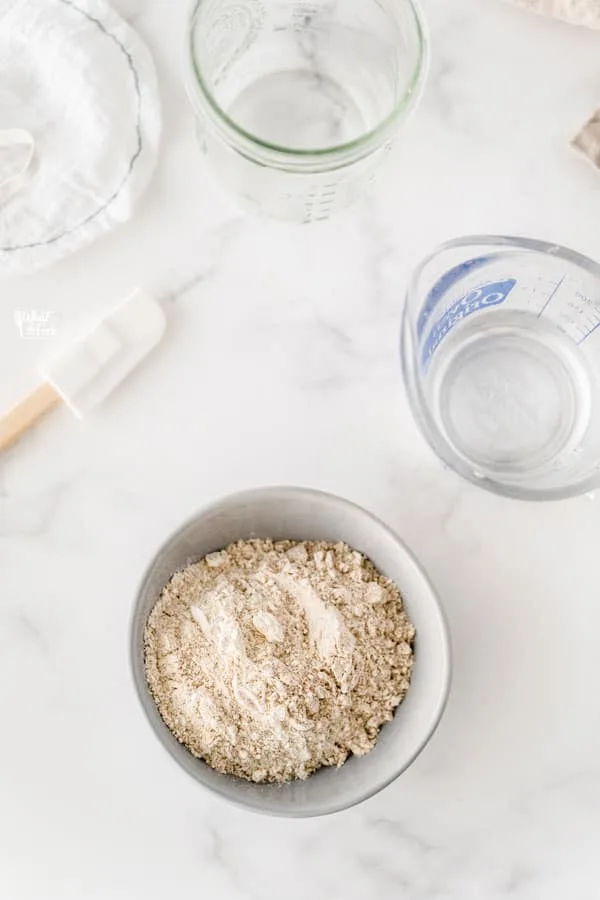
Flours to Avoid Using
- White Rice Flour – it’s ok if it’s in a blend you’re using but I wouldn’t recommend using it as the only flour for your starter.
- Starches – again, starches are ok if you’re using a flour blend but don’t use starch as your only flour for your starter.
- Nut Flours
- Fruit Flours – such as banana flour
- Wheat Flour – any wheat-based will mean your starter isn’t gluten-free.
- Rye Flour – Rye is a popular choice for sourdough starters but it’s not gluten-free.
Sourdough Starter Frequently asked questions and things you need to know!
- Can sourdough starter go bad? Yes, it can, unfortunately. If your sourdough starter develops mold or mildew, you’ll have to throw it out and start over.
- What is the liquid on top? The liquid that separates and goes to the top of your starter is called “hooch”. You can stir it back in or pour it off. Keeping it will give your starter a more pronounced sour flavor. Hooch is a sign that your starter is hungry.
- How long does it take for a sourdough starter to mature? It really depends on your environment and the flour you’re feeding it. A warmer environment will help a starter mature faster but it’s ok if your house is on the cool side (lower than 70 degrees) and your starter takes up to two weeks to mature.
- My brown rice flour starter was ready to bake with around 7 days, my Nightshade-Free Flour starter wasn’t ready until day 18, and my Bob’s Red Mill Starter was ready in about 11-12 days.
- How do you know when the sourdough starter is ready? When a sourdough starter is ready to bake with, it will have lots of bubbles and air pockets, it will double in size after feeding it, and after feeding it will follow a relatively predictable schedule of rising and doming (peaking) before falling. The pattern of doubling, doming, and falling will happen in a short amount of time; ideally within 8 hours of feeding.
- What is a ripe sourdough starter? A ripe starter is when it’s at its peak, the height of the bacteria and yeast growth. You can visibly see this because the starter will dome a the top (as mentioned above).
- What is considered an active starter? An active starter is growing and bubbling (producing carbon dioxide) after being fed. It’s at the stage where it’s expanding but hasn’t doubled in size yet and hasn’t reached its peak and isn’t quite ripe.
- Do I have to discard? It feels like a waste. Yes, you should discard because it leads to less waste in the long run. If you don’t discard, you’ll have to feed your starter double each day. After a couple days, the amount of flour and water you’d have to add would increase considerably.
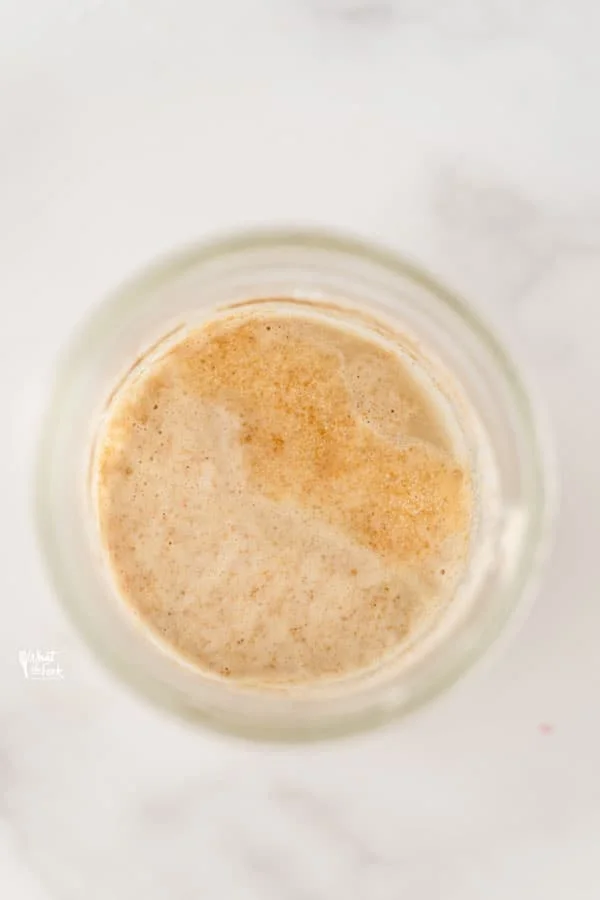
Coming up next in the sourdough starter series, you’ll learn:
- How to Maintain your Sourdough Starter once it’s Mature
- Recipes using gluten free sourdough starter discard
- How to make gluten free sourdough bread
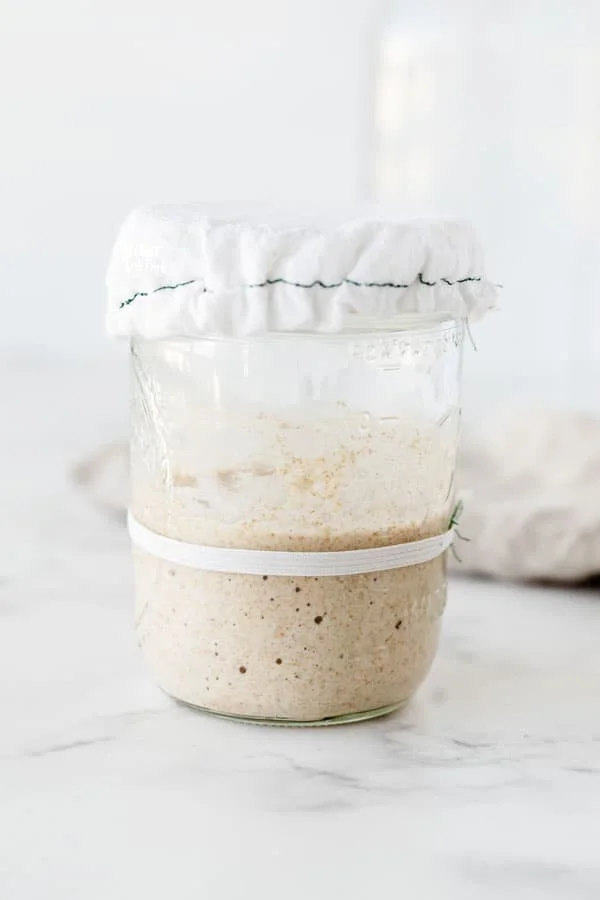
Be sure to follow me on Instagram and hashtag #whattheforkfoodblog or tag @whattheforkfoodblog – I love seeing what you make!
If you love this gluten-free sourdough starter recipe, be sure to follow me on social media so you never miss a post:
| Facebook | Twitter | Pinterest | Instagram | Youtube | Newsletter |
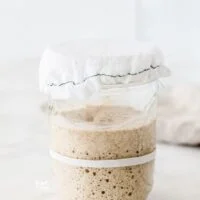
How to Make a Gluten Free Sourdough Starter
Ingredients
- 25 grams gluten-free flour
- 25 grams bottled or filtered water
Instructions
- Day 1 – Add 25 grams flour and 25 grams water to your glass jar. Mix well and scrape down the sides the best you can.Day 2 – No discard. Add 25 grams flour and 25 grams waterDay 3-6 Stir the starter and discard all but 25 grams of the starter. Add 25 grams flour and 25 grams water. Mix well and scrape down the sides the best you can.Day 7 – 10 Stir the starter and discard all but 25 grams of the starter. Add 50 grams flour and 50 grams water. Mix well and scrape down the sides the best you can.Day 11 – 14 Stir the starter and discard all but 25 grams. Add 75 grams flour and 75 grams water. Mix well and scrape down the sides the best you can.
- After day 14, you can continue to maintain this feeding schedule if you plan on baking with it soon or you can now store and maintain your starter in the refrigerator.
Notes
- I have four starters and each is made with different flour. The flours I’ve used are Bob’s Red Mill 1:1 Gluten-Free Baking Flour, Sorghum Flour, my Nightshade-Free Gluten-Free Flour Blend, and Brown Rice Flour. See the post for more flour recommendations and flours to avoid using.
- For best results, use bottled or filtered water. Tap water that has been chemically treated will prohibit the growth of (good) bacteria and wild yeast.
- Be sure to scrape the sides of your jar as cleanly as possible to prohibit the growth of mold or mildew.
- Keep your jar loosely covered. I use a Weck Jar with the rubber gasket removed. You can also cover your jar with a paper towel or cheesecloth and secure it with a rubber band. You don’t want your jar to be airtight.
- Don’t save the discard (for discard recipes) until your starter is at least 5-7 days old. It should be bubbling and almost doubling after each feeding.
- Discard from immature starters should be disposed of in the trash or composted. Do not pour it down the drain.
Recommended Products
Nutrition Information
Disclaimers
As an Amazon Associate and member of other affiliate programs, I earn from qualifying purchases.
Nutrition Facts are estimated and aren’t always accurate. Please consult a doctor or nutritionist if you have special dietary needs.
Did you make this sourdough starter? Leave a star rating and let me know in the comments! You can also leave a photo/comment on a pin for others to see.

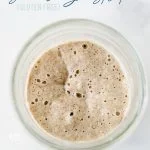
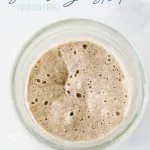
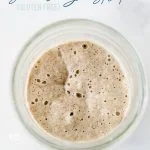
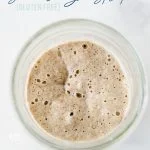
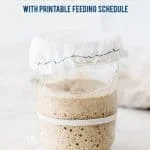
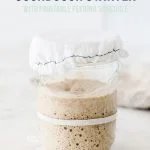
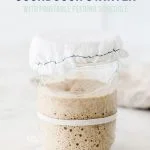
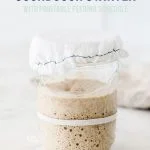
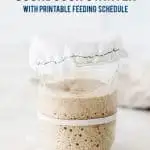
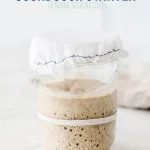
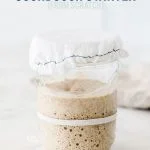
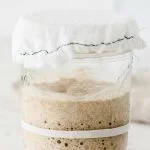
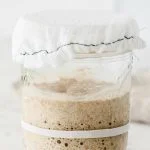
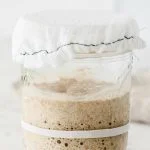
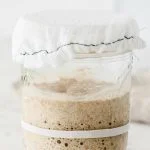
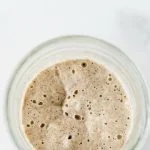
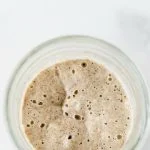
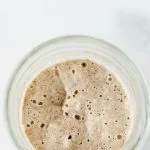
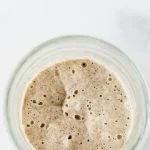
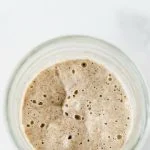
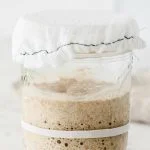
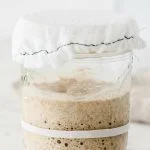
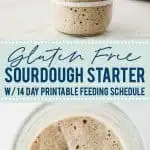


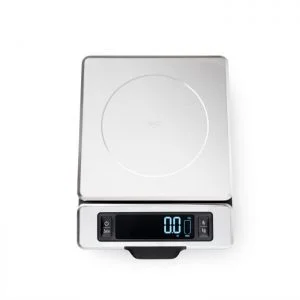
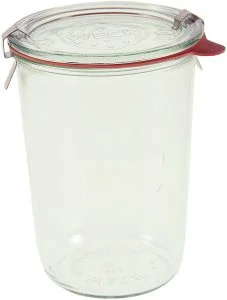

Can I use an established gluten starter and feed it gluten free flour. if I do this several feedings will it eventually become gluten free?
Technically, yes to the first question. But no to the second question and wouldn’t be safe for someone with Celiac disease.
I made this starter and I’m on day 14 tomorrow. I’m going to refrigerate it since I’m going out of town for two days. Then I’ll start the feeding and discard again. But if I keep getting rid of all but 25g how will it ever get big enough to use a lot with? Btw this recipe is very easy to follow
Thank you, I’m glad you find it so easy to follow! You can start saving your discard to make sourdough discard recipes. When you want to bake a loaf, you can feed your starter as much as you need to get the amount necessary for the recipe you use.
I made this with regular city tap water and it turned out great! I live in a cold climate, so I put it near the radiator where it would be warm (but not so close that the radiator would cook it).
Thanks for sharing, Sara!
Hi, once the starter is mature. Do we continue the 25 g starter to 75g flour and water ratio indefinitely for feeding or do we switch to 1:1:1?
Thank you!
I continue with 25:75:75. The flour to water ratio I use is 1:1 so you can easily make adjustments based on the amount you want/need.
Hi-trying out your starter, my last one didn’t work. Other recipes you add flour/water twice a day. With your recipe its only one time per day? Just need to confirm
Jane
I feed my starter once per day.
I’ve started my starter, idk what day I’m on but it’s around 2 weeks. I’m having to use more water than an equal amount, and every time I go to feed it just seems sooooo thick this is normal yea? It’s growing and doing well I’ve tried one other time and gave up because it did not go well. I have a normal starter so I thought I’d try this again, it just seems like it’s so thick idk how I’ll be a me to make anything with it once I’m at that point. I’m using winco brand (in bulk section) GF flour.
I haven’t tried that flour but each kind of gluten free flour or blend will behave differently in a starter. If you find you need more water, that’s fine! Just be sure you’re keeping track of the ratio of flour:water so you know how to adjust to any recipe you bake with it.
For those who don’t own a scale what are these in cups and or tbsp? (Or as close as you can get it?
I used bobs red mill gf flour and it did not work. It has been 11 days. What do I do?
I would try keeping it in a warmer place. If it’s too cold, the starter will be very slow.
I have been trying this with Bob’s 1:1 gluten-free baking flour. I have measured by grams and even got a warmer since my house is so cold. However, it is not doubling in size, but is rather dry and crumbly. Do you happen to have any suggestions
You can add a little more water, it sounds like your environment might be on the drier side.
Can I use Almond flour for starter?
No, almond flour would not work as a starter.
Question, can you use a 1 to 1 keto flour (King Arthur) as the flour for the sourdough starter?
I am doing low carb and even though the gluten free is better, the King Arthur keto flours is lower in carbs.
Hi Kristi, I haven’t tried this with a Keto flour blend so I can’t tell you for sure that it will work. Looking at the ingredients, it looks like there’s milk in it so I wouldn’t recommend using it for a starter.
Would this schedule work for normal flour as well?? Making a few different starters
Yes, it should!
I am on day 5 and something is not right. There is no liquid, no growth, no bubbles. I used coconut, gluten free flour…is that the problem?
Coconut flour doesn’t work for a sourdough starter. I would try using a grain based flour, like brown rice.
On your sourdough bread recipe, you mention that you have xanthum gum in your starter but I made your starter and it doesn’t have xanthum gum in it. Only sorghum flour and water. So do I add xanthum gum when I nake the sourdough bread? How much please?
You will add a binder (usually Psyllium husk or xanthan gum) depending on what the recipe you’re using calls for.
I have started making two sourdough starters from your instructions, (1) with my wife’s GF mix & (1) with brown rice. I have a kitchen scale & when I mixed the brown rice & water it seemed really dry compared to the GF mix. I threw away the first batch because I thought I did something wrong, did I? I am not on any social media platforms, so I don’t know how to get recipes or watch your videos, is there someplace else I can go to, to get these? I will get your recipe book but it would be nice to see the videos. Your explanations on this site are pretty easy to follow. Thanks, Dave
My starter doesn’t double and doesn’t bubble either. I used organic sorghum flour because I am wheat free, rice free, corn free, soy free. Its been 3 weeks today.Help
I use Annalise Robert’s flour blend, brown rice, potato starch, and tapioca flour. Will that work? Anxious to try…
Hi. I tried this and it hasn’t grown. I have skipped a couple days does that have something to do with it? Also I am using namaste flour would this cause a problem?
Not feeding for a few days will prohibit growth so try to keep to the feeding schedule. I haven’t tried with that particular flour.
I tried this starter with Bob’s Gluten free 1:1. When I woke up on day 3, the starter had overflowed the 1 litre jar! I took it down to 1/4, fed the starter and 12 hours later it was at the top of the jar again! I’m at the end of day 4, only feeding once a day at 9:00 am (after discarding 75%) and by 9:00 pm, I have to discard again as the starter has grown to the top of the jar again and I don’t want it to overflow overnight. There is no “doubling” and falling, just steady continuous growth! Any idea what’s happening here? Should I toss it and start again?
Don’t toss! It sounds like your starter is very happy! I recommend weighing the amount of starter you’re keeping after you discard. With a starter that active, you can discard all but 5g and feed from there. If that sounds like too little to you, do the 25g. It sounds like by eyeballing how much you’re discarding, you’re not discarding enough.
I’m so excited to try this! Any idea if it would work with oat flour as well?
I haven’t tested with oat flour but it works great with brown rice flour and it worked well with sorghum flour too.
Can you please be more specific in this final instruction of: “After day 14, you can continue to maintain this feeding schedule if you plan on baking with it soon or you can now store and maintain your starter in the refrigerator.”
I’m unsure what you mean by continuing to maintaining this feeding schedule. What exactly are you referring to. The day 11-14 schedule for forever? And if we keep it in the fridge, how often does it get cared for in the fridge?
Thanks.
You can find the long-term starter maintenance here: https://www.whattheforkfoodblog.com/2023/01/11/sourdough-starter-maintenance/
Do you feed daily? Example: Days 3-6, do this each day, or once in that 4 day period?
I feed once per day.
Your instructions are the BEST I’ve found! After reading a bunch of posts that just stressed me out I finally find yours that gave me the confidence to begin my sourdough experience. I’m on day 11 and so far so good! I was wondering if I could use the same recipe with regular flour since I bake bread for markets. Thanks!
Thank you Carrie! Yes you could.
Do you keep the starter in the fridge or what should be the temperature of its environment?
It depends on if your starter is already mature. I would keep it at room temperature with daily feedings for at least the first month. After that, you can keep at room temperature and feed daily if you’d like, or if you won’t be baking much, you can keep the starter in the refrigerator and feed weekly. You can find more in my post on How to Maintain a Sourdough Starter.
Do I keep the starter refridgerated for the first 14 days or just after it’s mature?
Keep it at room temperature and feed daily for the first 14 days (a month is better). Then you can maintain in the refrigerator if you’d like. You can read more on How to Maintain a Sourdough Starter for more details.
I want to start this but we don’t have a kitchen scale (and I’m trying to not spend money on extra things)… is there any option to do it without a scale?
Sorry, no. This is meant to be weighed for the most accurate results.
Looking forward to trying your recipes.
Thanks Cindy!
I am not used to measuring grams as I live in the US. Would you recommend rounding up to 1 ounce for the flour and water measurements?
Hi Anne, sourdough bread is traditionally made by measuring each ingredient by grams, even in the US. I don’t recommend rounding anything and I highly suggest investing in a digital kitchen scale for best results. Here’s an inexpensive one that I have used and recommend: https://amzn.to/3CCKeDD
Can I use cup 4 cup gluten flour for a starter?
Cup4Cup doesn’t work well for a starter because it contains dry milk. I used Bob’s Red Mill 1:1 Gluten Free Baking Flour with great results and I also have an excellent starter made with my Nightshade Free Flour Blend. But even just using brown rice flour or sorghum flour in your starter will work great.
Success! This is the first gluten-free starter that I’ve had success with. I’ve tried so many different blends of g-f grains and starches but always ended up with a very sleepy starter and had to use commercial yeast whenever I used it to make bread. But your instructions and recommendations did the trick. Thank you so-o-o much, Shay, for all your advice and step-by-step directions. I found it especially useful that you said the consistency was more like cottage cheese. I think I was hydrating my other starters too much (because I was used to making wheat-based sourdough starter). My first loaf of bread with your starter was fabulous. I’ve made several other loaves and have even branched out to make a sorghum-quinoa starter (I love the flavor that sorghum flour gives to g-f bread). You inspired me!
Thank you for this wonderful comment Kasha!
The process for the starter worked out great for me! I had King Arthur’s GF baking flour on hand and its been working out well. Since my house is on the chilly side, it took until about day 8 to start seeing bubbles. Now I’ve got a happy stinky started to work with. Excited to try the recipe for sourdough bread in a couple days.
That’s great to hear!!
I thought Nightshades were vegetables. Why would you need to make nightshade free bread?
White potatoes are nightshades and potato starch is found in many gluten free flour blends and gluten free products. I created a potato-free blend for my readers who cannot tolerate nightshades/potatoes or are following a low fodmap diet.
How long can a starter last in a ball jar in the fridge after the 14 days?
@Shay, how much do you feed the starter weekly?
You can feed it the same amount you normally do (75g flour, 75g water) and then refrigerate for 1 week. Discard, feed, and then place back in the refrigerator.
Take it out to feed once a week 🙂
Can I use the discard from day 3 as the foundation for a second starter?
@Nikki, what a great idea!
@Shay, thank you!!!
Yes you can!
What do you do if you miss a day?
As long as there’s no mold, pick up where you left off 🙂
I recently tried this starter, but it was always super thick and I wasn’t getting fermentation after a week. Is there something I was doing wrong? Should I just start over? Thank you, I look forward to trying your sourdough recipes!
As long as your starter doesn’t have mold, you don’t have to start over. If you’re using Bob’s 1:1 flour for your starter, it will be very thick but will still work. I actually recently switched my Bob’s Red Mill starter over to King Arthur’s Measure for Measure flour and it’s been much happier with that blend.
Your starter might also take a little longer to get going, especially if your house is on the cooler side. Try placing it on top of your stove after you’ve bakeed anything to give it a little warmth and see if that helps at all 🙂
Hi! Thanks for this recipe and all the info you’ve provided! I can’t seem to find a link to download the feeding schedule. Was that missed or am I just not seeing it? Thanks for your help!
Here it is! https://what-the-fork-food-blog.ck.page/9224e7dbcf
Can I use my existing wheat flour starter that is a few years old now, and start to feed it GF flour to come to something that is “mostly” Gluten Free after a few days time?
Theoretically, yes you could. It just wouldn’t be safe for anyone with Celiac Disease.
Is it absolutely necessary to discard that much of the starter each time I feed it? It seems like such a waste!
You can certainly feed your starter less to reduce waste but this feeding schedule helps to build a strong starter. Once you get the starter strong, you can reduce feedings by keeping 5g of your starter and feeding 25g flour and 25g water daily. You can also use the discard to bake some of my discard recipes. Here are a few-
Cornbread
Chocolate Cake
Chocolate Chip Cookies
Banana Bread
Pumpkin Bread
Each of these recipes uses a fairly large amount of discard so really, you don’t have to waste much at all. My 4-Ingredient Sourdough Bread is also made with discard. Happy baking!
Can this be stored in the fridge the whole time?
yes!
Hi! This sounds so wonderful and I’m excited to get started. I have an all-purpose gf flour blend without xanthan gum. Do you recommend that I add some to the bread starter?
Yes you will need to add xanthan gum!
I have been waiting for a blog that I trust to break down the sourdough process. Shay has done just that. My starter is perfect thanks to her precise, yet simple process. The Facebook videos and posts are also so helpful and informative!
I started a GF sourdough starter with a 50/50 combination of sorghum/teff flour. It smelss nearly rancid to me (I have used wheat sourdough starter in the past, before going GF so I know that smell. After 3 days of this GF starter, I started over, fearing it had gone bad. But now on day 2 of the exact same thing, it smells foul again. I’m just wondering if perhaps I’m not used to these particular flours? I added a few grains of a high quality yeast to maybe help it along. I know you can’t smell it to advise me, but I was wondering if you know if the sorghum starter maybe has a different smell than wheat-based?? Thanks!!
Gluten free flours will definitely have a different smell than regular flour. However, I think it’s the Teff flour that’s causing your starter to have an unpleasant smell.
In the last days of the recipe you are tossing all but 25 grams and adding 150 grams combined of flour and water. So your starter never is more than 175 grams. But if I read it right, your sourdough bread recipe uses 200 grams of starter. So how do you have enough starterr?
The day before baking, I feed my starter 100g flour and 100g water.
Hi,
I tried to start this last night with a combo of teff and sorghum and the same weight in water. It’s like a thick paste. Is that right? I’m waiting to be added to the Baking Club FB group to see if the answer is on there but that request hasn’t been accepted. Just want to know if I went wrong somewhere!
@Tanica, I had the same experience when I used buckwheat flour. I looked at pictures and read other recipes and decided to add a little bit more water. I’m on day three and things seem to be progressing well. I think the 1-1 ratio is based on volume not weight. I measure out the 25 g of flour in. A little dish that has ridges on the side and use that to gauge a similar amount of water. I think I’ve found ~35g of water works well.